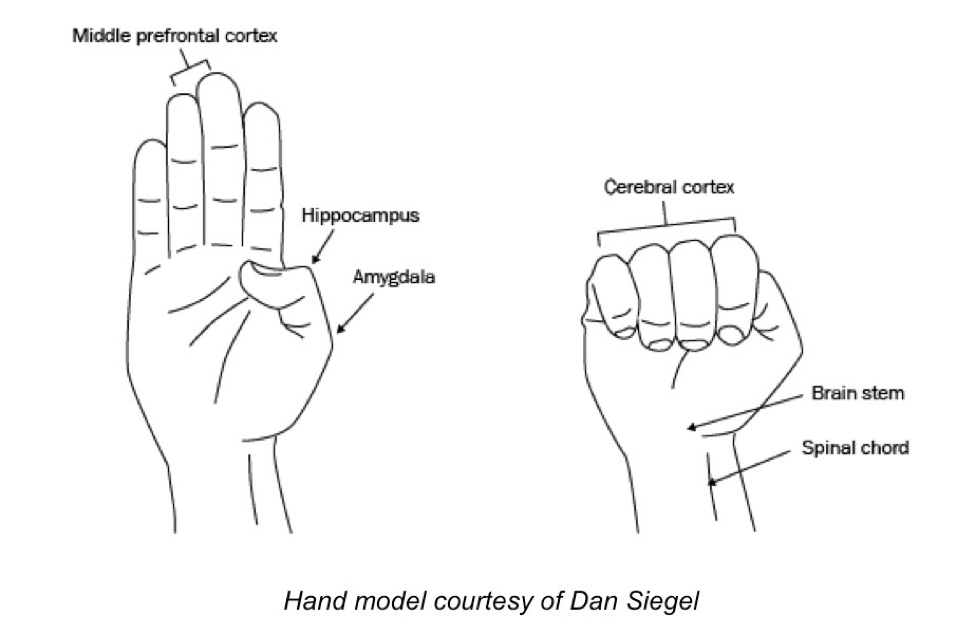Dr Siegel is a Clinical Professor of Psychiatry at the UCLA School of Medicine and the founding co-director of the Mindful Awareness Research Centre at UCLA. He is an award-winning educator, a Distinguished Fellow of the American Psychiatric Association and recipient of several honorary fellowships. He has written extensively about trauma in children and adults, and has been published both professionally as a psychiatrist and an author.
Dr Dan Siegel’s Hand Model of the Brain also known as “The Hand Brain” provides an avenue in which we can portray brain structure and better understand why it can be complicated to control negative responses when we are overloaded with powerful emotions such as stress and anger.
The Hand Brain can be used as a guide for Young People and Caregivers to better understand their own emotions. Young People are more susceptible to stress because of developmental factors, including their pre-frontal cortexes not being fully developed until around the age of 25. The Hand Brain can assist Young People and Caregivers to visualise what is happening inside of their brain while they are stressed, flustered, or upset. This understanding can further help them recognise and act to overcome negative emotions more effectively.

The concept of “Flipping your Lid” is a part Dr Siegel’s hand brain theory. There has been substantial analysis and research about the effects that trauma has on the brain. Research shows that three areas of the brain are activated during a trauma response: the brain stem, the limbic system, and the cortex. When we are calm, these three parts of the brain work harmoniously with one another. However, when someone experiences trauma whether that be physical or emotional, these three brain areas disengage from one another causing havoc within.
The brain stem is often referred to as the reptilian brain. It takes care of our bodily functions that we need to survive, such as lung and heart function. The limbic system comprises of three areas: the hypothalamus (hormone producer), the amygdala (emotion regulator) and the hippocampus (memory maker). This system is for the most part, responsible for our emotions and relationships. Essentially, it helps us assess situations and determine if we are safe or not. The cortex controls rational thinking.
Within the first stages of someone experiencing a trauma or a trauma response, the brain stem shoots into action and initiates the fight, flight, freeze, or fawn response. This alerts the limbic system that something is wrong and to release higher levels of cortisol (a stress hormone), sending the amygdala into overdrive to cause a fear response. There might be other hormones being produced such as adrenaline and noradrenaline to help prepare the body for fight or flight, this is what makes our heartbeat faster and prepare us to run away or fight. Meanwhile the hippocampus is trying to keep record of what is happening and may only keep a snapshot. It might remember only certain sounds, smells, tastes, and visuals. This is why in the aftermath of a traumatic event, normal situations can trigger a fear response. The cortex disconnects from these other parts of the brain. This can make it difficult for people to relay what had happened or what they are experiencing.
Using Dr Siegel’s hand model, in the aftermath of trauma or a trauma response the cortex (the four fingers facing up) is disconnected or “flipped up”. The hippocampus and amygdala are essentially running the show. When we are in a state of hyper-awareness and fear-activated we tend to be quick to anger, and that includes for Young People. In the instance where a Young Person is hostile they may be displaying a trauma response and unaware that they are trying to protect themselves. Some other responses can be shutting down, this can look like zoning out or drifting off. During these states of hyper vigilance and shutting down using communicative language may not be an effective tool to help them calm down and self-regulate. You can try using kinaesthetic strategies such as deep breathing, yoga, physical exercise, and other grounding activities to help them reach a calmer place where they can process their emotions and experiences.
